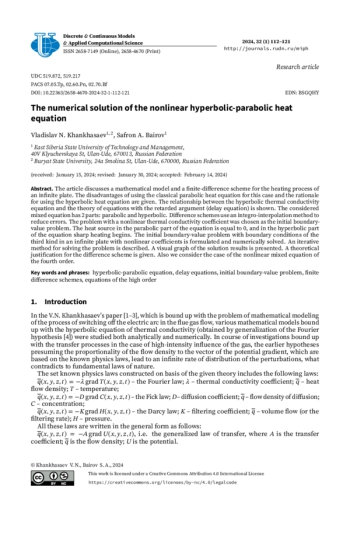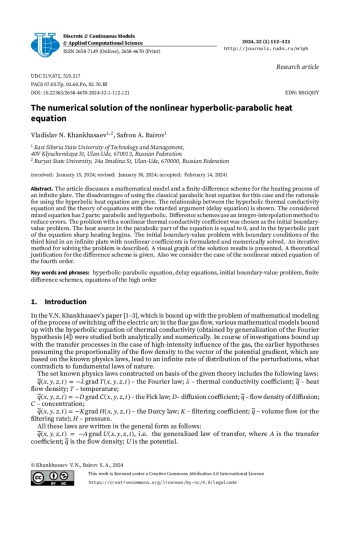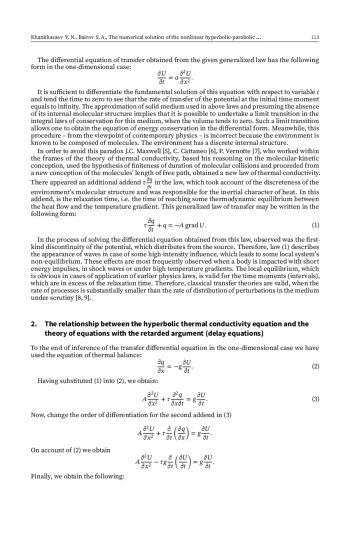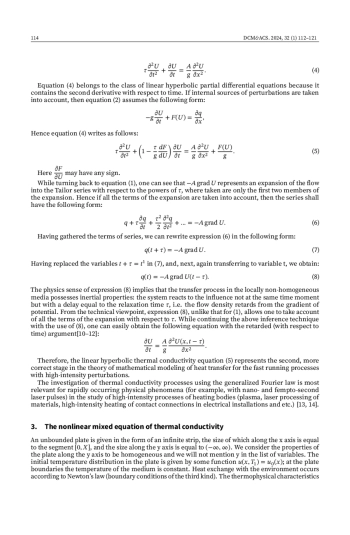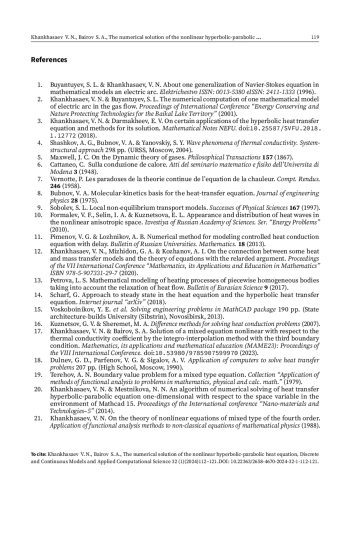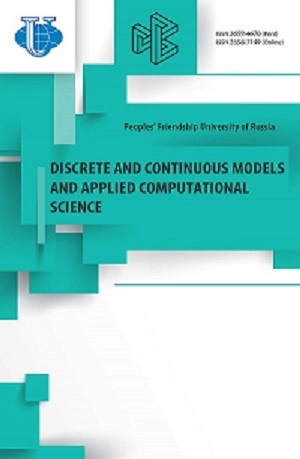The article discusses a mathematical model and a finite-difference scheme for the heating process of an infinite plate. The disadvantages of using the classical parabolic heat equation for this case and the rationale for using the hyperbolic heat equation are given. The relationship between the hyperbolic thermal conductivity equation and the theory of equations with the retarded argument (delay equation) is shown. The considered mixed equation has 2 parts: parabolic and hyperbolic. Difference schemes use an integro-interpolation method to reduce errors. The problem with a nonlinear thermal conductivity coefficient was chosen as the initial boundaryvalue problem. The heat source in the parabolic part of the equation is equal to 0, and in the hyperbolic part of the equation sharp heating begins. The initial boundary-value problem with boundary conditions of the third kind in an infinite plate with nonlinear coefficients is formulated and numerically solved. An iterative method for solving the problem is described. A visual graph of the solution results is presented. A theoretical justification for the difference scheme is given. Also we consider the case of the nonlinear mixed equation of the fourth order.
Идентификаторы и классификаторы
In the V. N. Khankhasaev’s paper [1–3], which is bound up with the problem of mathematical modeling of the process of switching off the electric arc in the flue gas flow, various mathematical models bound up with the hyperbolic equation of thermal conductivity (obtained by generalization of the Fourier hypothesis [4]) were studied both analytically and numerically. In course of investigations bound up with the transfer processes in the case of high-intensity influence of the gas, the earlier hypotheses presuming the proportionality of the flow density to the vector of the potential gradient, which are based on the known physics laws, lead to an infinite rate of distribution of the perturbations, what contradicts to fundamental laws of nature.
Список литературы
1. Buyantuyev, S. L. & Khankhasaev, V. N. About one generalization of Navier-Stokes equation in mathematical models an electric arc. Elektrichestvo ISSN: 0013-5380 eISSN: 2411-1333 (1996).
2. Khankhasaev, V. N. & Buyantuyev, S. L. The numerical computation of one mathematical model of electric arc in the gas flow. Proceedings of International Conference “Energy Conserving and Nature Protecting Technologies for the Baikal Lake Territory” (2001).
3. Khankhasaev, V. N. & Darmakheev, E. V. On certain applications of the hyperbolic heat transfer equation and methods for its solution. Mathematical Notes NEFU. doi:10.25587/SVFU.2018. 1.12772 (2018).
4. Shashkov, A. G., Bubnov, V. A. & Yanovskiy, S. Y. Wave phenomena of thermal conductivity. Systemstructural approach 298 pp. (URSS, Moscow, 2004).
5. Maxwell, J. C. On the Dynamic theory of gases. Philosophical Transactions 157 (1867).
6. Cattaneo, C. Sulla conduzione de calore. Atti del seminario matematico e fisiko dell’Universita di Modena 3 (1948).
7. Vernotte, P. Les paradoxes de la theorie continue de l’equation de la chauleur. Compt. Rendus. 246 (1958).
8. Bubnov, V. A. Molecular-kinetics basis for the heat-transfer equation. Journal of engineering physics 28 (1975).
9. Sobolev, S. L. Local non-equilibrium transport models. Successes of Physical Sciences 167 (1997).
10. Formalev, V. F., Selin, I. A. & Kuznetsova, E. L. Appearance and distribution of heat waves in the nonlinear anisotropic space. Izvestiya of Russian Academy of Sciences. Ser. “Energy Problems” (2010).
11. Pimenov, V. G. & Lozhnikov, A. B. Numerical method for modeling controlled heat conduction equation with delay. Bulletin of Russian Universities. Mathematics. 18 (2013).
12. Khankhasaev, V. N., Mizhidon, G. A. & Kozhanov, A. I. On the connection between some heat and mass transfer models and the theory of equations with the relarded argument. Proceedings of the VII International Conference “Mathematics, its Applications and Education in Mathematics” ISBN 978-5-907331-29-7 (2020).
13. Petrova, L. S. Mathematical modeling of heating processes of piecewise homogeneous bodies taking into account the relaxation of heat flow. Bulletin of Eurasian Science 9 (2017).
14. Scharf, G. Approach to steady state in the heat equation and the hyperbolic heat transfer equation. Internet journal “arXiv” (2018).
15. Voskoboinikov, Y. E. et al. Solving engineering problems in MathCAD package 190 pp. (State architecture-builds University (Sibstrin), Novosibirsk, 2013).
16. Kuznetsov, G. V. & Sheremet, M. A. Difference methods for solving heat conduction problems (2007).
17. Khankhasaev, V. N. & Bairov, S. A. Solution of a mixed equation nonlinear with respect to the thermal conductivity coefficient by the integro-interpolation method with the third boundary condition. Mathematics, its applications and mathematical education (MAME23): Proceedings of the VIII International Conference. doi:10.53980/9785907599970 (2023).
18. Dulnev, G. D., Parfenov, V. G. & Sigalov, A. V. Application of computers to solve heat transfer problems 207 pp. (High School, Moscow, 1990).
19. Terehov, A. N. Boundary value problem for a mixed type equation. Collection “Application of methods of functional analysis to problems in mathematics, physical and calc. math.” (1979).
20. Khankhasaev, V. N. & Mestnikova, N. N. An algorithm of numerical solving of heat transfer hyperbolic-parabolic equation one-dimensional with respect to the space variable in the environment of Mathcad 15. Proceedings of the International conference “Nano-materials and Technologies–5” (2014).
21. Khankhasaev, V. N. On the theory of nonlinear equations of mixed type of the fourth order. Application of functional analysis methods to non-classical equations of mathematical physics (1988).
Выпуск
Другие статьи выпуска
Average equations of motion of relativistic charged particles in the field of HF (high frequency) wave packets are obtained in the range of cyclotron resonance in the case of strong LF (low frequency) electric field. Strong electric field means that the characteristic velocity of the particle comparable with the electric drift velocity (
Study of spherically symmetric time-periodic standing waves of the
The problem of finding equilibrium configurations of one-component charged particles, induced by external electrostatic fields in planar systems, is a subject of active studies in fundamental as well in experimental investigations. In this paper the results of numerical analysis of the equilibrium configurations of charged particles (electrons), confined in a circular region by an infinite external potential at its boundary are presented. Equilibrium configurations with minimal energy are searched by means of special calculation scheme. This computational scheme consists of the following steps. First, the configuration of the system with the energy as close as possible to the expected energy value in the ground equilibrium state is found using a model of stable configurations. Next, classical Newtonian molecular dynamics is used using viscous friction to bring the system into equilibrium with a minimum energy. With a sufficient number of runs, we obtain a stable configuration with an energy value as close as possible to the global minimum energy value for the ground stable state for a given number of particles. Our results demonstrate a significant efficiency of using the method of classical molecular dynamics (MD) when using the interpolation formulas in comparison with algorithms based on Monte Carlo methods and global optimization. This approach makes it possible to significantly increase the speed at which an equilibrium configuration is reached for an arbitrarily chosen number of particles compared to the Metropolis annealing simulation algorithm and other algorithms based on global optimization methods.
The blockage of the propagation path is one of the major challenges preventing the deployment of fifth-generation New Radio systems in the millimeter-wave band. To address this issue, the Integrated Access and Backhaul technology has been proposed as a cost-effective solution for increasing the density of access networks. These systems are designed with the goal of avoiding blockages, leaving the question of providing quality-ofservice guarantees aside. However, the use of multi-hop transmission negatively impacts the end-to-end packet latency. In this work, motivated by the need for latency reduction, we design a new link activation policy for self-backhauled Integrated Access and Backhaul systems operating in half-duplex mode. The proposed approach utilizes dynamic queue prioritization based on the number of packets that can be transmitted within a single time slot, enabling more efficient use of resources. Our numerical results show that the proposed priority-based algorithm performs better than existing link scheduling methods for typical system parameter values.
For one-dimensional inhomogeneous (with respect to the spatial variable) linear parabolic equations, a combined approach is used, dividing the original problem into two subproblems. The first of them is an inhomogeneous one-dimensional Poisson problem with Dirichlet–Robin boundary conditions, the search for a solution of which is based on the Chebyshev collocation method. The method was developed based on previously published algorithms for solving ordinary differential equations, in which the solution is sought in the form of an expansion in Chebyshev polynomials of the 1st kind on Gauss–Lobatto grids, which allows the use of discrete orthogonality of polynomials. This approach turns out to be very economical and stable compared to traditional methods, which often lead to the solution of poorly defined systems of linear algebraic equations. In the described approach, the successful use of integration matrices allows complete elimination of the need to deal with ill-conditioned matrices.
The second, homogeneous problem of thermal conductivity is solved by the method of separation of variables. In this case, finding the expansion coefficients of the desired solution in the complete set of solutions to the corresponding Sturm–Liouville problem is reduced to calculating integrals of known functions. A simple technique for constructing Chebyshev interpolants of integrands allows to calculate the integrals by summing interpolation coefficients.
The analysis of trajectory dynamics and the solution of optimization problems using computer methods are relevant areas of research in dynamic population-migration models. In this paper, four-dimensional dynamic models describing the processes of competition and migration in ecosystems are studied. Firstly, we consider a modification of the “two competitors—two migration areas” model, which takes into account uniform intraspecific and interspecific competition in two populations as well as non-uniform bidirectional migration in both populations. Secondly, we consider a modification of the “two competitors—two migration areas” model, in which intraspecific competition is uniform and interspecific competition and bidirectional migration are non-uniform. For these two types of models, the study is carried out taking into account the variability of parameters. The problems of searching for model parameters based on the implementation of two optimality criteria are solved. The first criterion of optimality is associated with the fulfillment of such a condition for the coexistence of populations, which in mathematical form is the integral maximization of the functions product characterizing the populations densities. The second criterion of optimality involves checking the assumption of the such a four-dimensional positive vector existence, which will be a state of equilibrium. The algorithms developed on the basis of the first and second optimality criteria using the differential evolution method result in optimal sets of parameters for the studied population-migration models. The obtained sets of parameters are used to find positive equilibrium states and analyze trajectory dynamics. Using the method of constructing self-consistent one-step models and an automated stochastization procedure, the transition to the stochastic case is performed. The structural description and the possibility of analyzing two types of population-migration stochastic models are provided by obtaining Fokker–Planck equations and Langevin equations with corresponding coefficients. Algorithms for generating trajectories of the Wiener process, multipoint distributions and modifications of the Runge–Kutta method are used. A series of computational experiments is carried out using a specialized software package whose capabilities allow for the construction and analysis of dynamic models of high dimension, taking into account the evaluation of the stochastics influence. The trajectory dynamics of two types of population-migration models are investigated, and a comparative analysis of the results is carried out both in the deterministic and stochastic cases. The results can be used in the modeling and optimization of dynamic models in natural science.
There are two main approaches to the numerical solution of the eikonal equation: reducing it to a system of ODES (method of characteristics) and constructing specialized methods for the numerical solution of this equation in the form of a partial differential equation. The latter approach includes the FSM (Fast sweeping method) method. It is reasonable to assume that a specialized method should have greater versatility. The purpose of this work is to evaluate the applicability of the FSM method for constructing beams and fronts. The implementation of the FSM method in the Eikonal library of the Julia programming language was used. The method was used for numerical simulation of spherical lenses by Maxwell, Luneburg and Eaton. These lenses were chosen because their optical properties have been well studied. A special case of flat lenses was chosen as the easiest to visualize and interpret the results. The results of the calculations are presented in the form of images of fronts and rays for each of the lenses. From the analysis of the obtained images, it is concluded that the FSM method is well suited for constructing electromagnetic wave fronts. An attempt to visualize ray trajectories based on the results of his work encounters a number of difficulties and in some cases gives an incorrect visual picture.
In this paper, we study the effect of using the Metropolis–Hastings algorithm for sampling the integrand on the accuracy of calculating the value of the integral with the use of shallow neural network. In addition, a hybrid method for sampling the integrand is proposed, in which part of the training sample is generated by applying the Metropolis–Hastings algorithm, and the other part includes points of a uniform grid. Numerical experiments show that when integrating in high-dimensional domains, sampling of integrands both by the Metropolis–Hastings algorithm and by a hybrid method is more efficient with respect to the use of a uniform grid.
This work is the second part of a large bibliographic review of active queue management algorithms of the Random Early Detection (RED) family, presented in the scientific press from 1993 to 2023. This part provides data on algorithms published from 2006 to 2015.
The article presents the results of the evaluation of quartiles of scientific conferences presented by leading rating agencies. The estimates are based on the use of three methods of multivariate statistical analysis: linear regression, discriminant analysis and neural networks. A training sample was used for evaluation, including the following factors: age and frequency of the conference, number of participants and number of reports, publication activity of the conference organizers, citation of reports. As a result of the study, the linear regression model confirmed the correctness of the quartiles exposed for 77% of conferences, while the methods of neural networks and discriminant analysis gave similar results, confirming the correctness of the quartiles exposed for 81 and 85% of conferences, respectively.
Статистика статьи
Статистика просмотров за 2025 год.
Издательство
- Издательство
- РУДН
- Регион
- Россия, Москва
- Почтовый адрес
- 117198, г. Москва, ул. Миклухо-Маклая, д. 6
- Юр. адрес
- 117198, г Москва, Обручевский р-н, ул Миклухо-Маклая, д 6
- ФИО
- Ястребов Олег Александрович (РЕКТОР)
- E-mail адрес
- rector@rudn.ru
- Контактный телефон
- +7 (495) 4347027
- Сайт
- https://www.rudn.ru/
